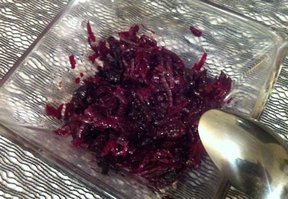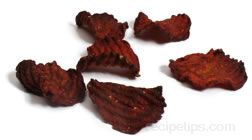Another member of the beet family that is often associated with beetroots is chard. Also known as Swiss chard, leaf beet, spinach beet, silver beet, seakale beet, spinach beet or white beet, this plant grows up instead of down, so it produces broad leaves rather than a bulbous root. The leaves are sought for their tender texture and mild flavor. The leaf and stalk can be eaten raw or the leaves can be prepared in the same manner as spinach and the stalks can be prepared like asparagus.
The typical round garden beet is sold fresh or canned and can be used in a number of ways. The beet root can be eaten raw as well as baked, boiled, steamed, sautéed, or stewed to be served as a side dish or added to soups. Beets can also be pickled and used as a condiment. Both the root and the greens can be used as an ingredient in a variety of salad dishes. Or beets can be grated and added to salads and to garnish soups.
When selecting, choose beets that are small to medium size (1 to 2 inches in diameter), nicely developed and do not look dried or cracked in appearance. Beet shoots with leaves that are to be eaten should be fresh looking, containing leaves that are dark to bright green and not shriveled. When preparing beets to be cooked, wash the beet gently prior to cooking, keep a short amount of stem on the beet, and to retain the nutrients and color do not peel the tender skin until after they are cooked, either by boiling the beets in water or by wrapping the beets in foil and roasting in an oven at 375ºF. Beets can be easily peeled while they are warm. An easy way to remove the skin is to wear rubber gloves, using the rubber gripping action of the material to peel the skin away from the beet. The gloves also protect the hands from becoming stained from the beet juices. Beet shoots and leaves should also be washed thoroughly to remove dirt and particles. Another way to retain or alter the color of the beets when cooking is to add an acidic ingredient such as a little lemon juice or vinegar to the water, which will make the color of the beet look brighter. Adding an alkaline ingredient such as baking soda deepens the color of the beet flesh. When storing fresh beets or their greens, do not wash prior to storing. Trim the green stalks to 1 or 2 inches in length and place the round bulbous root in the refrigerator crisper. Fresh beetroots can be kept for 2 to 4 weeks before loosing their flavor. Fresh beet greens should be placed in plastic containers or bags that allow some air to enter where they can be kept for 4 to 6 days. Fresh beets do not freeze well, however cooked beets can be frozen to be stored for future use.












